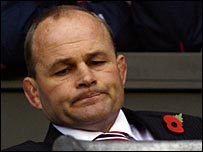
I was at Twickenham on Saturday watching England get beaten by the Argentineans. It was a pretty miserable spectacle and I wondered what it might tell us about effecting Change.
Listening to the commentators after the match everyone was asking if it was time for the head coach, Andy Robinson to go. Certainly there seemed to be 60,000 England fans who thought he should.
 I researched this a bit more, read the papers and the opinion seems to be “Yes, it is time”, but the more interesting question is “Why?” Do people think that he is to blame for the teams performance? The captain, Martin Cory, said that the players were responsible for a dreadful performance, they understood the strategy and failed to execute it. Others suggest that the England club structure makes it very tough for him to get the right people, in the right condition. It was also pointed out that he was not solely responsible for the selection any more.
I researched this a bit more, read the papers and the opinion seems to be “Yes, it is time”, but the more interesting question is “Why?” Do people think that he is to blame for the teams performance? The captain, Martin Cory, said that the players were responsible for a dreadful performance, they understood the strategy and failed to execute it. Others suggest that the England club structure makes it very tough for him to get the right people, in the right condition. It was also pointed out that he was not solely responsible for the selection any more.
 So, should he go, and if so, why?
So, should he go, and if so, why?
This is where I think it gets interesting to non-rugby fans. What the stakeholders (the fans, the Rugby Football Union, the players, the sponsors) require is success. This requires both a change in attitude, aptitude and performance.
How do you get this? Well first of all there is a need to communicate that Change is required, and sometimes to signal how important this is, it is necessary to send a clear, loud signal. Sacking the ‘chief executive’ does this. This sends an unequivocal message that more of the same is not acceptable. It may not be wholly fair on a rational analysis of the facts, but when serious Change is needed, clarity is absolutely necessary.
How was the leadership on the day? Also dreadful. No clear leadership from those who should be doing it, no support for the leaders we had. It seems very unfair that the individuals who were in positions of responsibility might have been doing their level best and failed due to circumstances beyond their control, and yet, if this was a business it would be on the verge of bankruptcy and something radical would need to be done. So what is required?
Interestingly, it is important to know that failure is part of the learning process and has to be allowed. However, there comes a time when decisive action is required, and then someone needs to step in an go “This isn’t working” and the cycle starts again.
One can wonder if the time to anticipate this failure might have been at the height of our World Cup glory. It would have been a brave ‘Chairman’ who stepped in at this pinnacle of achievement and said “Wonderful! But you don’t have enough ‘gas in the tank’ to do it again, so I’m rebuilding” . Would the stakeholders have accepted this?
A brave company keeps reinventing itself, even when it is succeeding. After all, any formula that is successful will be copied, and usually improved on.
So, are you resting on your laurels, or wrestling with the question of “How do we improve on this?” If you, or your people are in their comfort zone now, then it is probably only a matter of time before this story could be yours!
Testimonials:
Following the course at Henley, Richard has supported and coached me through the assessments and also through the period of uncertainty and change within the business. Richards's comfortable and relaxed style helped me work through new evaluation techniques and models. - General Manager - Estates National Grid Wireless
click here for more testimonials

What's New?
Article: Management and Change Management
Blog: We've been Trumped... or Brexit pt II
Be not angry that you cannot make others as you wish them to be, since you cannot make yourself as you wish to be. - Thomas a Kempis